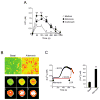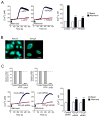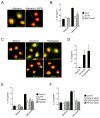The danger signal, extracellular ATP, is a sensor for an airborne allergen and triggers IL-33 release and innate Th2-type responses
- PMID: 21357533
- PMCID: PMC3062674
- DOI: 10.4049/jimmunol.1003020
The danger signal, extracellular ATP, is a sensor for an airborne allergen and triggers IL-33 release and innate Th2-type responses
Abstract
The molecular mechanisms underlying the initiation of innate and adaptive proallergic Th2-type responses in the airways are not well understood. IL-33 is a new member of the IL-1 family of molecules that is implicated in Th2-type responses. Airway exposure of naive mice to a common environmental aeroallergen, the fungus Alternaria alternata, induces rapid release of IL-33 into the airway lumen, followed by innate Th2-type responses. Biologically active IL-33 is constitutively stored in the nuclei of human airway epithelial cells. Exposing these epithelial cells to A. alternata releases IL-33 extracellularly in vitro. Allergen exposure also induces acute extracellular accumulation of a danger signal, ATP; autocrine ATP sustains increases in intracellular Ca(2+) concentration and releases IL-33 through activation of P2 purinergic receptors. Pharmacological inhibitors of purinergic receptors or deficiency in the P2Y2 gene abrogate IL-33 release and Th2-type responses in the Alternaria-induced airway inflammation model in naive mice, emphasizing the essential roles for ATP and the P2Y(2) receptor. Thus, ATP and purinergic signaling in the respiratory epithelium are critical sensors for airway exposure to airborne allergens, and they may provide novel opportunities to dampen the hypersensitivity response in Th2-type airway diseases such as asthma.
Figures








References
-
- Cookson W. The immunogenetics of asthma and eczema: a new focus on the epithelium. Nat Rev Immunol. 2004;4:978–988. - PubMed
-
- Holt PG, Macaubas C, Stumbles PA, Sly PD. The role of allergy in the development of asthma. Nature. 1999;402:B12–17. - PubMed
-
- Lambrecht BN, Hammad H. Biology of lung dendritic cells at the origin of asthma. Immunity. 2009;31:412–424. - PubMed
Publication types
MeSH terms
Substances
Grants and funding
- R01 AI034486/AI/NIAID NIH HHS/United States
- R29 AI034486/AI/NIAID NIH HHS/United States
- HL095811/HL/NHLBI NIH HHS/United States
- R01 AI049235/AI/NIAID NIH HHS/United States
- R56 DK074010/DK/NIDDK NIH HHS/United States
- R56 AI034486/AI/NIAID NIH HHS/United States
- AI34486/AI/NIAID NIH HHS/United States
- R21 HL095811/HL/NHLBI NIH HHS/United States
- AI49235/AI/NIAID NIH HHS/United States
- R01 AI071106/AI/NIAID NIH HHS/United States
- DK074010/DK/NIDDK NIH HHS/United States
- R56 AI049235/AI/NIAID NIH HHS/United States
- R01 HL110539/HL/NHLBI NIH HHS/United States
LinkOut - more resources
Full Text Sources
Other Literature Sources
Molecular Biology Databases
Miscellaneous

